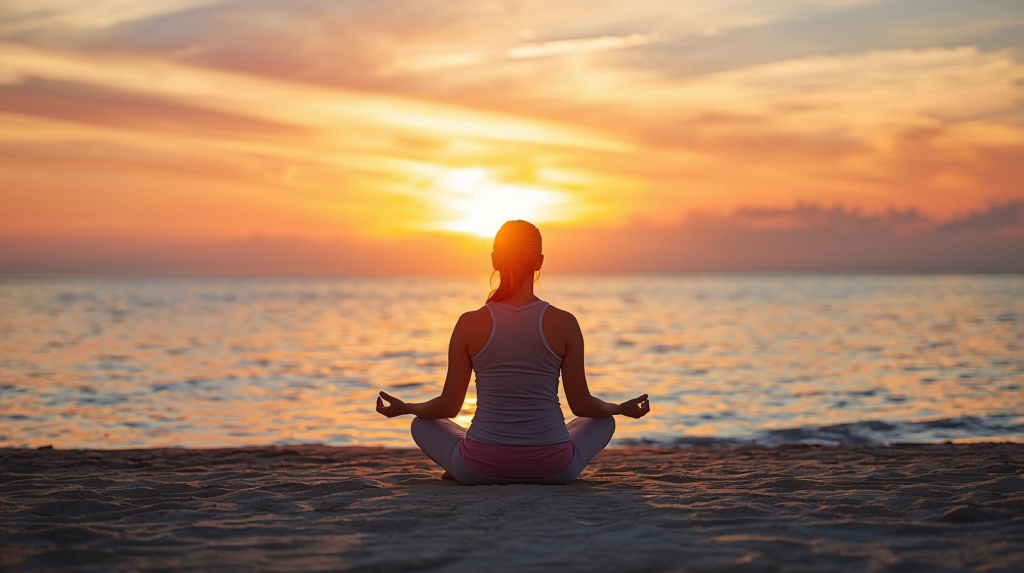
A Beginner’s Guide to Meditation: How to Start Your Journey to Inner Peace
Meditation has been practiced for thousands of years. But it feels more relevant now than ever. In our fast-paced world of endless notifications, work stress, and sleepless nights, many people feel mentally scattered. Plus, they feel drained.
If you’ve ever wished you could quiet your mind, meditation is a powerful tool. Also, it can create space for calm in the middle of chaos. The good news? You don’t need hours of silence or a mountain retreat to benefit. Instead, you can start right where you are.
This guide will walk you through what meditation is. It also covers why it works. Plus, we’ll show you how to begin today.
What Is Meditation?
Meditation is the practice of training your mind to focus and redirect thoughts. At its core, it’s about building awareness and presence. You can do this through your breath, a mantra, or simply noticing feelings in your body.
There are many different approaches. These include mindfulness meditation, guided meditation, body scans, and loving-kindness practices. But all share the same goal: creating mental clarity and balance.
The Science-Backed Benefits of Meditation
Modern research confirms what ancient traditions knew. Meditation supports both mind and body.
Reduces Stress & Anxiety — First, mindfulness meditation lowers cortisol, the stress hormone. So you feel calmer and less reactive
Mindfulness meditation lowers cortisol, the stress hormone, leaving you calmer and less reactive.”
National Centre for Complementary and Integrative Health – Meditation
Improves Sleep Quality — Second, a study found meditation helped adults fall asleep faster. Also, it reduced nighttime wake-ups
A randomized trial found meditation helped adults fall asleep faster and reduced night-time disturbances.”
PMC: Mindfulness Meditation Improves Sleep Quality
Enhances Focus & Productivity — Third, regular meditation strengthens attention and focus. This is key in a distraction-filled world.
Supports Well-Being — Fourth, studies show drops in symptoms of depression and anxiety. This happens in both beginners and long-term users.
Boosts Kindness & Self-Awareness — Finally, loving-kindness meditation can reduce negative self-talk. Plus, it improves relationships.
For more natural health practices with strong scientific support, explore our Natural Health articles.
How Benefits Unfold Over Time
Meditation benefits happen slowly. Here’s what to expect:
First few sessions: You’ll likely feel more relaxed right after meditating. But your mind may feel very busy during practice.
First week: You might notice better sleep quality. Also, you may feel slightly less reactive to daily stress.
2-4 weeks: Focus often improves. Plus, you’ll start to notice your thought patterns more clearly.
1-3 months: Balance becomes more stable. Also, you’ll find it easier to stay calm during hard times.
Remember, progress isn’t always linear. Some days will feel easier than others. But doing it daily is what creates lasting change.
Setting Up Your Meditation Space
Creating the right space helps you succeed. Here are simple tips:
Choose a consistent spot. This could be a corner of your bedroom, a comfortable chair, or even your car. But the key is using the same place each time.
Make it comfortable. Sit in a chair with back support or on a cushion on the floor. Also, keep your spine naturally straight but not rigid.
Cut out distractions. Turn off your phone or put it in airplane mode. Plus, dim harsh lights if possible.
Set the mood. Some people like soft music or nature sounds. But others prefer complete silence. So try both to see what works for you.
How to Start Meditating
The most important step is simply beginning. Here’s a simple, beginner-friendly approach:
Find Your Position — First, sit comfortably in a chair or on a cushion. Then, place your hands on your knees or in your lap. Also, keep your spine straight but relaxed.
Set a Timer — Next, start with just 5 minutes. You can extend slowly as you build the habit. Plus, use a gentle bell or chime sound.
Focus on Your Breath — Then, pay attention to the natural rhythm of inhaling and exhaling. Don’t try to change your breathing. Instead, just watch it.
Notice Wandering Thoughts — When your mind drifts (and it will), gently guide it back to your breath. This isn’t failure. In fact, it’s the practice working.
End with Thanks — Before finishing, pause to acknowledge the time you’ve given yourself. Also, notice how you feel compared to when you started.
👉 You don’t need perfection—just daily practice. Even a few minutes daily creates real change.
Best Times to Meditate
Morning meditation sets a calm tone for your entire day. Plus, your mind is often clearest before daily distractions begin. So many people find this the most effective time.
Evening meditation helps you unwind from the day’s stress. Also, it can improve sleep quality by calming your nervous system. But avoid meditating too close to bedtime if it makes you too alert.
Midday breaks can reset your focus and energy. Even 3-5 minutes between meetings can make a difference. Plus, this helps prevent afternoon energy crashes.
The best time is whenever you can be regular. So choose a time that fits your schedule and stick with it.
Common Challenges & How to Beat Them
It’s normal to face obstacles at first. Here are some common roadblocks and practical fixes:
| Challenge | Solution |
|---|---|
| Wandering Mind | First, notice the thought. Then label it “thinking.” Finally, return to the breath. This is normal and part of the process. |
| Restlessness | Try walking meditation or shorter sessions (2–3 minutes). Also, gentle stretching before sitting can help. |
| Doubt | Keep a simple journal. Track mood, sleep, or focus changes week by week. |
| Lack of Time | First, link meditation to daily habits (morning coffee, bedtime routine). Also, remember that 3 minutes counts too. |
| Self-Criticism | Use loving-kindness meditation to build gentleness toward yourself. Plus, remember that “bad” meditation days are still helpful. |
| Physical Discomfort | Adjust your position as needed. Also, try meditating in a chair if floor sitting is uncomfortable. |
For more ways to build strength and reduce stress naturally, read our guide to St John’s Wort and mood balance.
Many beginners experience mood swings or self-criticism when starting a practice.
Learn how herbs like St John’s Wort can support mood balance.
Different Types of Meditation You Can Try
Mindfulness Meditation — First, focus on your breath and present moment awareness. This is great for beginners.
Body Scan — Second, slowly bring attention to each part of your body, releasing tension. This also helps with physical relaxation.
Guided Meditation — Third, follow an app, teacher, or recording to stay focused. Plus, this provides structure for beginners.
Loving-Kindness (Metta) — Fourth, repeat phrases of goodwill toward yourself and others. This builds kindness and reduces negative self-talk.
Mantra Meditation — Fifth, silently repeat a calming word or phrase. This also gives your mind a specific focus point.
Walking Meditation — Finally, practice mindful awareness while walking slowly. This is perfect if sitting still feels hard.
Try different types to find what works best with you. Also, don’t be afraid to switch between styles as your needs change.
A 7-Day Beginner’s Plan
To make meditation a habit, start small and build slowly:
Day 1–2: First, try 5 minutes of breath awareness. Just focus on inhaling and exhaling naturally.
Day 3–4: Next, do 5 minutes with a guided meditation app or YouTube video. This provides outside structure and support.
Day 5–6: Then, try a body scan or loving-kindness practice. Also, notice which type feels most natural to you.
Day 7: Finally, reflect on your week. Notice changes in mood, sleep, or focus. Plus, celebrate that you completed a full week of practice.
After week one, slowly increase session length by 2-3 minutes every few days. But only do this if longer sessions feel comfortable.
What to Expect as a Beginner
Your mind will wander a lot. This is completely normal. In fact, noticing that your mind has wandered and bringing it back is the actual practice.
Some days will feel “easier” than others. Your meditation will vary daily. Also, hard sessions are often the most valuable for building mental strength.
Physical discomfort may arise. First, adjust your position as needed. Also, remember that some restlessness is normal as your body learns to sit still.
Feelings might surface. Meditation can bring up emotions or memories. This is normal and often part of the healing process. But if intense emotions arise, consider working with a qualified teacher.
Progress happens slowly. Don’t expect big changes after a few sessions. Instead, look for subtle shifts in how you respond to stress over weeks and months.
Building Your Practice
Start small and be regular. Five minutes daily is better than 30 minutes once a week. Also, doing it daily builds the habit more than duration.
Use reminders and triggers. First, set phone alarms or link meditation to existing habits. For example, meditate right after brushing your teeth.
Track your progress. Keep a simple log of your practice. Plus, note any changes in sleep, mood, or stress levels.
Be patient with yourself. Some days meditation will feel great. But other days it will feel hard. Both are part of the journey.
Consider joining a group or class. Meditating with others provides support and motivation. Also, teachers can offer personal guidance.
The key to meditation is consistency. Just like any new routine, it’s not about willpower—it’s about building habits that last. One of the most effective methods is habit stacking, where you attach meditation to something you already do daily, like morning coffee or bedtime.”
Learn more in this Complete Habit Stacking System guide from Everyday Mastery.
Final Thoughts
Meditation isn’t about emptying your mind. Instead, it’s about learning to notice your thoughts and gently guiding them. With regular practice, even just a few minutes a day, you can create more calm, clarity, and strength in your life.
Remember, there’s no “perfect” way to meditate. The best practice is the one you’ll actually do daily. So start where you are, use what you have, and do what you can.
Most importantly, be kind to yourself throughout this journey. Every moment you spend in meditation is a gift to your future self. Plus, the skills you develop on the cushion will naturally flow into your daily life.
Don’t get down if progress feels slow. The benefits of meditation build up over time and are often subtle at first. But with time and daily practice, you’ll notice big changes in how you handle stress, relate to others, and feel daily life.
Start your journey today, and let meditation become a cornerstone of your well-being.
👉 Take action now: First, set a 5-minute timer right now and try your first session. Then, mark the same time tomorrow in your calendar to build the habit.
Want to explore more natural approaches to health and balance? Visit our Natural Health section.

